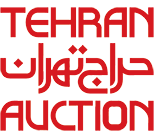Tapping into his extensive, profound experience with the language of picture, color and material, Jafar Rouhbakhsh created the present painting in 1985. It is a remarkable example of the period when he attained a perfect understanding of abstract compositions and khaki textures in his work. Limited range of colors in the artwork serves painterly objectives that the artist is trying to exhibit in a broad array of works. Diverse tones of brown, starting with pale, cracked cream shades, lead to thick, dark layers, thus producing colors such as ochre, alizarin brown, khaki, and gold in different parts of the work. It is similar to the work of an archeologist who has dug only part of an old object for the first time, while we know that a larger portion of a precious treasure is still beneath the surface. It denotes a moment of presence and absence whose ephemeral state signifies both existence and non-existence.
Jafar Rouhbakhsh is an artist inspired by Saqqakhaneh School of art. It seems that pale lines and illegible quasi-inscriptions in the margins are inspired by the school. Nevertheless, it is obvious that unlike periods of work with color that are closer to formal and color achievements of the Saqqakhaneh approach, Rouhbakhsh is presenting an abstract language with an emphasis on numerous layers of paint. In fact, Rouhbakhsh fills the gap between two different tastes in Iranian art, bridging Saqqakhaneh and abstract painting.
Color is a priority for Rouhbakhsh, even though it may not be diverse at times. Application of color in his painting is comparable to the use of language in poetry, tantamount to a main pillar. Language attains eloquence in poetry, just as colors become articulate in painting. As the artist himself comments,
“Painting without color is like poetry with no words. I believe painting amounts to an expression of colors. Design in painting has the same function as words in a language, and color is the meaning that words can convey. In poetry, a poet lifts the words to the highest pinnacles of meaning, just as a painter gives expression to colors, revealing their true stature. Painting is my language. I created, as much as I could, such a language in my work. The language of painting is the language of color and design. In other words, painting expresses colors, in the same way that colors express a painter.”
Evolution of Rouhbakhsh’s works indicates that he practiced with colored, abstract compositions and khaki textures for a long time. The evolution encompassed small geometric forms and diverse colors. Then in the last years of his artistic career, Rouhbakhsh experimented with traditional Iranian subjects like drawing of flowers and birds (gol o morq) and application of bright, gemlike colors. Perhaps presence of young Rouhbakhsh in Hossein Behzad’s studio had an effect on his approach toward tradition, as this tendency is, more or less, obvious in his entire career mostly in the form of Iranian abstract art. Familiar elements of Iranian applied and decorative arts, including kelim, carpet and local handicrafts, can be seen in a majority of his works. Such a diversity of experience made it possible for him to practice copper relief, mural painting, production of gravure, painting on colored glass and lithography in addition to painting.
A hidden nature can be detected in a majority of Rouhbakhsh’s works, especially in the painting on display. He also experienced living in the nature once in his personal life. He believed, “The connection between man and the nature in the work of a painter can be compared to a trickle of water that reaches a flower, anticipating moisture, vigor and bloom. A painter both borrows colors and learns rules from the nature. Nature is the most deserving teacher. I have long embraced the nature, but this is not an excursion. I have never dared to encounter the nature face to face. I have had a strange, secret journey into the nature for some time. Then I returned to the confines of my room and painted all that memory onto the canvas. It was perhaps an easier way for me to portray a world of light and color within the confines of a small canvas.”
It must be noted that one of Jafar Rouhbakhsh’s works was sold for $133,000 at Christie’s Dubai auction, April 2008.

